Caring for Old Maps
by
Bob Brooke
Much of the time, the paper on which an old map has been printed shows
signs of wear and aging. Anything printed on paper is subject to
mishandling and improper storage, and old maps are no exception. Over
time, paper can become stained, frayed or torn at outer edges and
weakened at folds if it was originally a part of a book or an atlas.
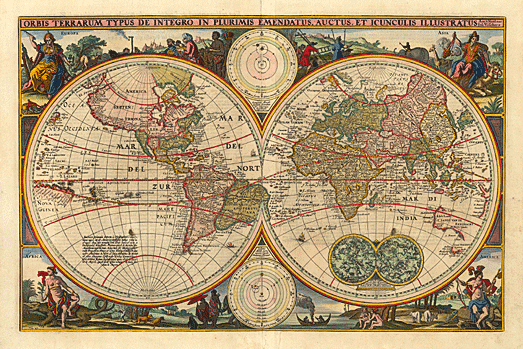
From the 1700s to the early 1800s, printers engraved maps on handmade
rag paper which had a strong fiber content as it's base. In the 19th
century, at the height of the Industrial Revolution, publishers began
using machine-made paper which was inexpensive and readily available and
made from a wood pulp base. While the early rag paper had little or no
acid in its content, the later wood pulp paper was extremely acidic.
Over time that acidity made the paper brittle, stained and yellowed at
the folds. This is probably the most important reason why the early
engravings have survived in much better condition than their later
machine-made counterparts.
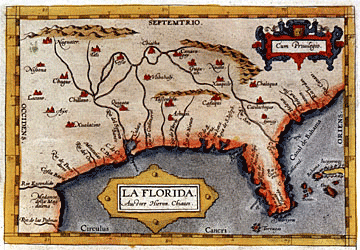 Another reason why early maps, especially those before the 19th century,
have survived is that their owners valued them far more than maps are
today and often kept them in libraries and government institutions and
only brought them out and displayed them on special occasions for
important dignitaries, scholars, and visitors. A cardinal rule in map
collecting is the less people handle a map, the better its chance of
survival as even the cleanest hands have oils and body chemicals that
can be transmitted to the paper with harming effects. Another reason why early maps, especially those before the 19th century,
have survived is that their owners valued them far more than maps are
today and often kept them in libraries and government institutions and
only brought them out and displayed them on special occasions for
important dignitaries, scholars, and visitors. A cardinal rule in map
collecting is the less people handle a map, the better its chance of
survival as even the cleanest hands have oils and body chemicals that
can be transmitted to the paper with harming effects.
Sea Charts
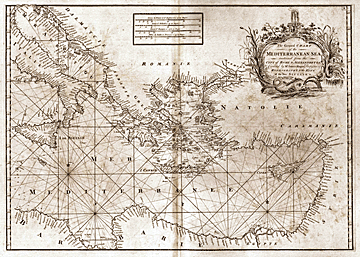 Early sea charts present a different problem because printers engraved
them on rag paper or its equivalent, and often backed them with linen
fabric. Sea captains subjected these charts to all the rigors of life at
sea. Coffee, oil and water stains are common on old charts, as well as
tears and abrasions due to mishandling by sailors in rough seas.
Captains or their mates often folded and refolded them or rolled them
tightly, when damp, to fit into sailor's lockers or sea bags which
caused soiling and staining to sink even deeper into the paper surface. Early sea charts present a different problem because printers engraved
them on rag paper or its equivalent, and often backed them with linen
fabric. Sea captains subjected these charts to all the rigors of life at
sea. Coffee, oil and water stains are common on old charts, as well as
tears and abrasions due to mishandling by sailors in rough seas.
Captains or their mates often folded and refolded them or rolled them
tightly, when damp, to fit into sailor's lockers or sea bags which
caused soiling and staining to sink even deeper into the paper surface.
Conditions Plaguing Old Maps
One of the prime conditions plaguing old maps and charts is foxing, a
type of mold that shows itself as a series of brown dots that appear on
many old maps that have been stored in damp, humid attics or storerooms
for a long time. Foxing is a fungal growth that grows on old paper and
books if the relative humidity is greater than 65 percent over a
prolonged period and can ultimately destroy the cellulose fiber in the
paper if left untreated. Many early maps came out of books and atlases,
which users stored in boxes or closets where the air was still. The mold
spores in the air could then attack the paper particularly feeding on
any acid inherent in the book and paper contents.
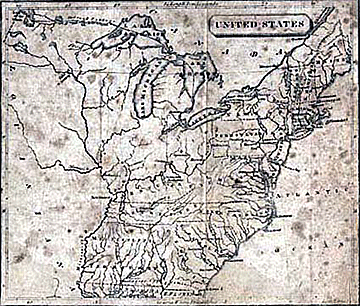 Just as mold spores can attack paper, so can worms or larva which eat
their way through the paper causing small holes in a map's surface. Worm
holes are more common on old sea charts where the chart has been exposed
to the open damp atmospheric conditions at sea where the larva can
breed. Just as mold spores can attack paper, so can worms or larva which eat
their way through the paper causing small holes in a map's surface. Worm
holes are more common on old sea charts where the chart has been exposed
to the open damp atmospheric conditions at sea where the larva can
breed.
Offsetting is another common defect found on old maps. When this
happens, the text or image from a previous page shows through onto it's
neighbor in a book or atlas. In the early days of printing, the oils in
the inks took a long time to dry and if the map or print wasn’t
completely dry before being bound into a book or atlas, sections of
printed matter could transfer onto the back of a following sheet when
pressed against it in the bound volume.
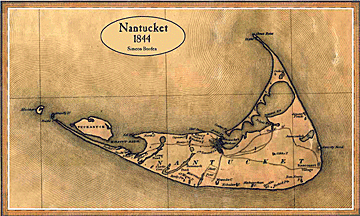 During the 19th century, large wall maps of States, Counties and Towns,
became popular for schools, town offices and for display in houses of
the wealthy. Makers fitted them with poles at top and bottom and backed
them with a linen fabric. They also shellacked them in what people
considered at that time, a way to protect the surface of a map from
damage due to touching and handling by schoolchildren and others tracing
their streets and houses and land boundaries on the maps. Unfortunately,
over time the shellac dried out and cracked, causing the map surfaces to
lift from the backing which became torn and frayed. In many cases the
poles fell out as the backing gave way and once their popularity waned,
their owners rolled them and stored them in attics and closets, where
their deterioration continued, attacked often by mold spores, worms and
damp. Restoring these maps is extremely difficult as the old shellac has
to be removed before any conservation work can be attempted. During the 19th century, large wall maps of States, Counties and Towns,
became popular for schools, town offices and for display in houses of
the wealthy. Makers fitted them with poles at top and bottom and backed
them with a linen fabric. They also shellacked them in what people
considered at that time, a way to protect the surface of a map from
damage due to touching and handling by schoolchildren and others tracing
their streets and houses and land boundaries on the maps. Unfortunately,
over time the shellac dried out and cracked, causing the map surfaces to
lift from the backing which became torn and frayed. In many cases the
poles fell out as the backing gave way and once their popularity waned,
their owners rolled them and stored them in attics and closets, where
their deterioration continued, attacked often by mold spores, worms and
damp. Restoring these maps is extremely difficult as the old shellac has
to be removed before any conservation work can be attempted.
Six Things to
Avoid in Caring for Your Old Maps
There are things you can do to preserve your collection of old maps
without resorting to major conservation methods, which can be costly and
time-consuming. However, if a map has major tears or staining, you
should take it to a professional paper conservator.
But there are some simple things to avoid when caring from your old
maps:
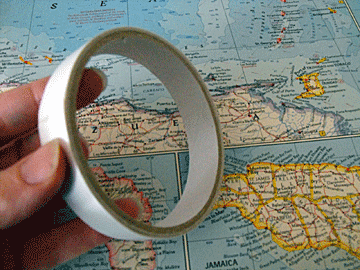 1.
Never
use ordinary Scotch or Magic Tape to repair even minor tears.
Instead, use a product called "Document Repair Tape" which is an
archival acid free mending tissue that’s thin but strong. It’s also
non-yellowing, unlike Scotch Tape which yellows with age, and
virtually disappears when burnished. 1.
Never
use ordinary Scotch or Magic Tape to repair even minor tears.
Instead, use a product called "Document Repair Tape" which is an
archival acid free mending tissue that’s thin but strong. It’s also
non-yellowing, unlike Scotch Tape which yellows with age, and
virtually disappears when burnished.
2.
Never use an ordinary eraser to remove soiling from the surface of
old maps since erasing tends to lift the inks off the engraved
surface. Instead, use a product called "Document Cleaning Pad,"
which is non-abrasive and contains a super soft grit-free powder
that absorbs surface soil and finger prints.
3.
Never
mount a map or print onto a backing board with an adhesive, as
adhesives can destroy the delicate fibers in the paper and cause
staining. It also causes loss of value in the map especially if the
map is a rare or scarce item.
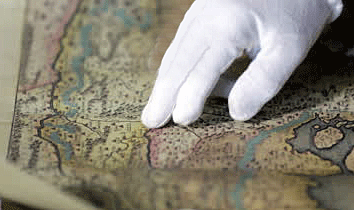 4.
Never
handle old maps with your bare hands. Purchase a pair or two of
inexpensive white cotton gloves. 4.
Never
handle old maps with your bare hands. Purchase a pair or two of
inexpensive white cotton gloves.
5.
Never
roll a map tightly for storage or shipping. Rolling puts a strain on
the delicate fibers in the paper. Instead, place your maps in clear,
archival polyester bags and lay them flat in storage cabinets. These
flat cabinets are made especially for storage of artwork,
blueprints, maps and charts and measure approximately 40"wide by 28"
deep. The cabinets come in either three- or five-drawer sizes and
are available at art and office supply stores.
6.
Never frame a map without an acid-free mat or spacers between it the
glass. The framed map has to breathe so moisture can't build up
under the glass in humid or damp conditions.
To read
more of my articles, please
visit
my Web site.
<
Back to Caring for Your Collections
Archives
Next Article >
|
